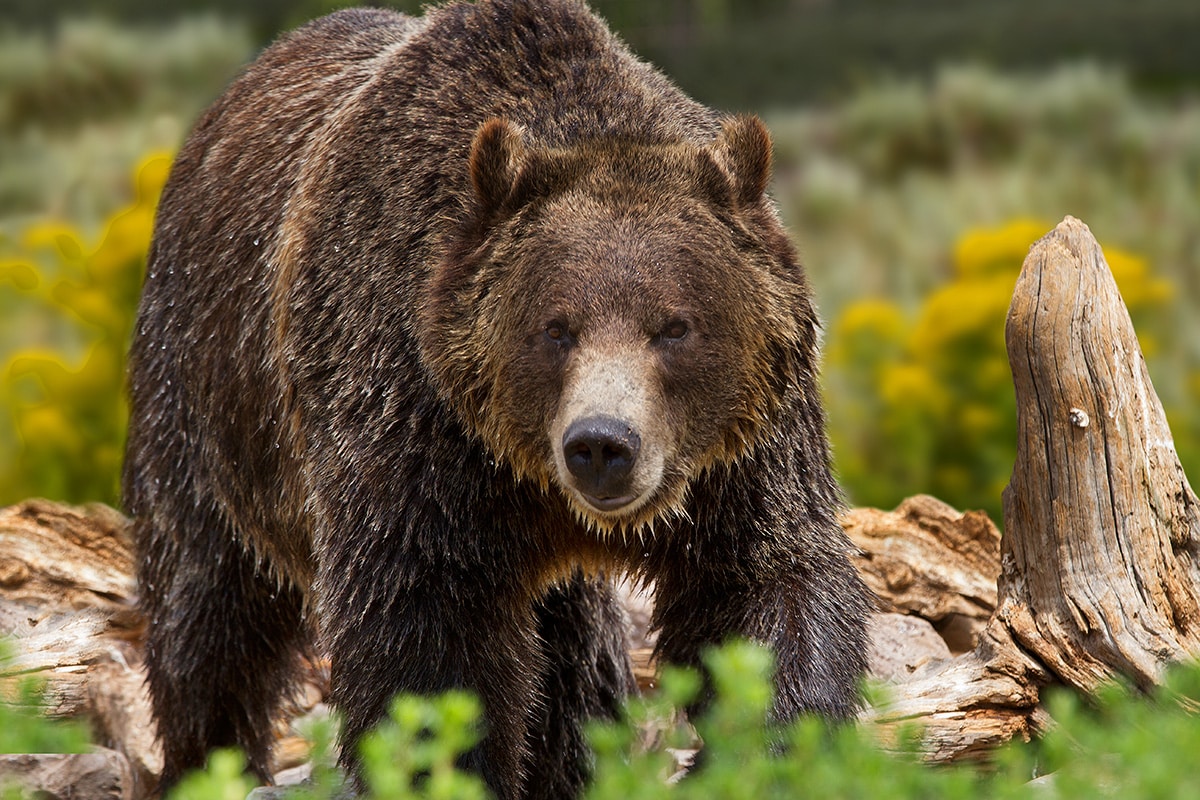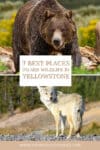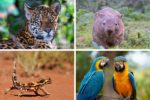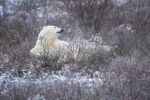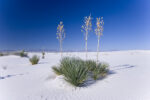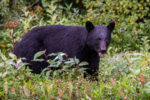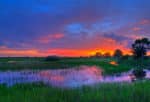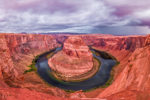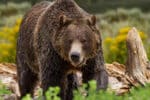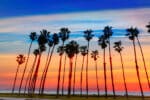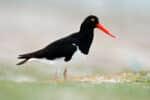Whether your passion is mountains, canyons, hot springs, waterfalls, or wildlife, Yellowstone National Park in Wyoming and Montana has everything that you could dream of. It is the oldest and one of the main iconic national parks in the US.
During your visit, don’t be surprised when you see herds of bison grazing in the fields, black and grizzly bears leading their cubs across the road, or bighorn sheep scaling a cliff. Yellowstone is one of the best safari destinations in the US.
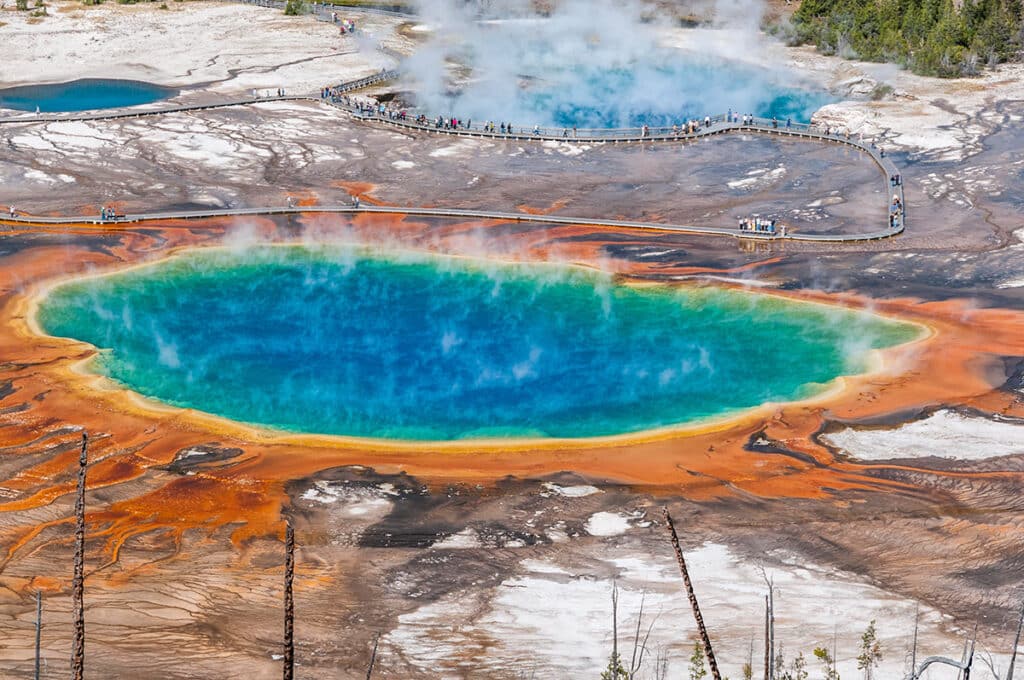
Yellowstone is home to the largest concentration of animals in the contiguous United States, so there’s almost always a chance that you’ll spot wildlife on your visit to the park!
Keen to maximise your chances of wildlife encounters? If your answer is yes, this post is for you – a detailed guide to the best places to see wildlife in Yellowstone National Park. Make sure to add some of these spots to your Yellowstone National Park itinerary!
This guide assumes you have your own set of wheels and can explore the part independently. If you don’t wish to drive, don’t despair – you can visit Yellowstone on a day tour either from Jackson in Wyoming or from West Yellowstone in Montana.
Where to See Wildlife in Yellowstone National Park
Below you’ll find 7 of the most popular places to spot wildlife in and around this national park. Animals from bears, bison, elk, and more populate these areas.
Each of these locations is home to a variety of different animals, and you have a good chance of spotting different species of wildlife.
Lamar Valley
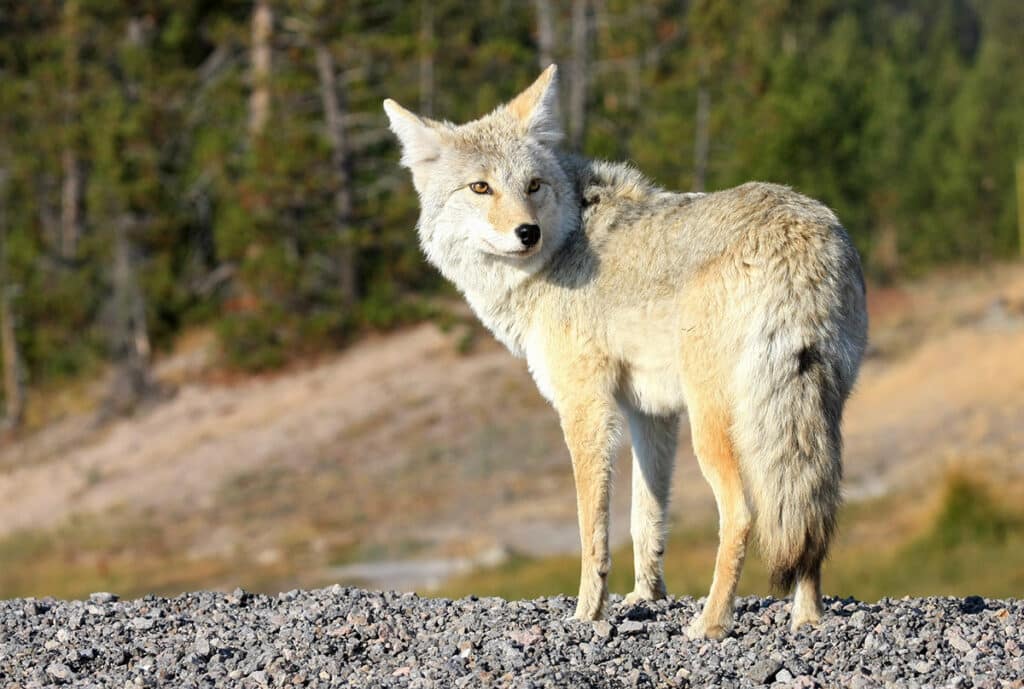
Perhaps the most popular and well-known place to spot animals in Yellowstone National Park is Lamar Valley.
Located in the northeastern corner of the park, the closest entrance is the Northeast Entrance, which is found after a beautiful drive from Red Lodge and the Beartooth Highway.
This large grassland is home to so many grazing animals that it has been nicknamed “America’s Serengeti,” after Africa’s popular national park.
It’s nearly impossible to pass through Lamar Valley without seeing at least one head of grazing bison.
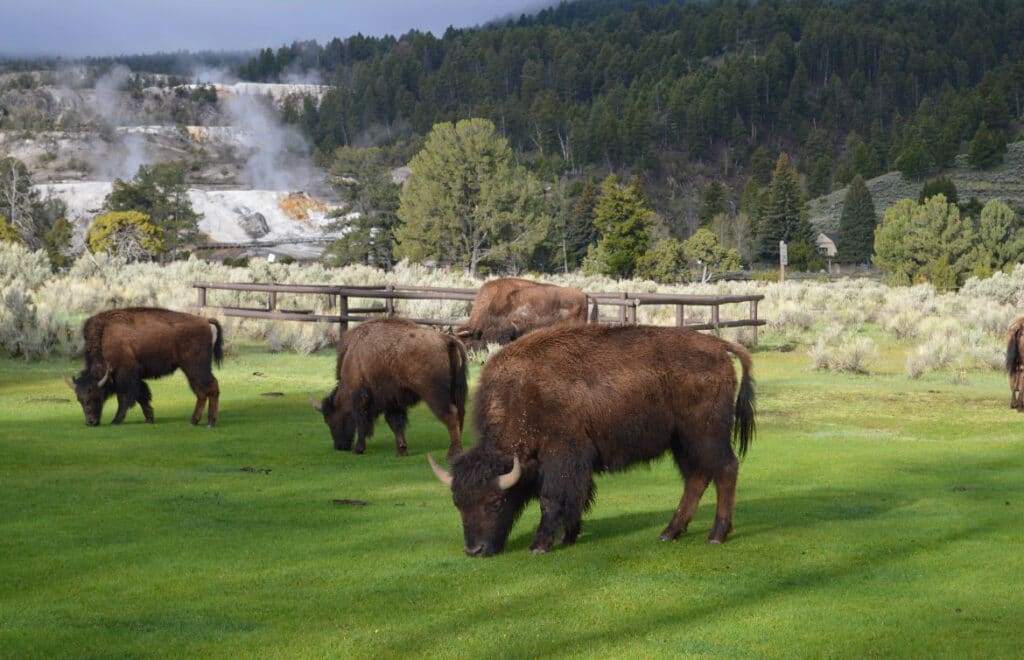
If you’re visiting in the spring, you might even have the opportunity to see some of the baby bison as they learn to walk, run, graze, and enjoy their beautiful home.
Black bears are also often seen in Lamar Valley but sometimes require a closer look to spot, as they tend to stay further away from humans.
Although if you see a large group of people gathered on the side of the road, you might be in luck!
Spotting a wolf at Yellowstone is one of the most sought-after experiences and can most often be done in Lamar Valley, where the Junction Butte Pack likes to hang out.
No matter what type of animals you’re searching for, there are plenty of pullouts along the road through Lamar Valley where you can stop and enjoy.
Hayden Valley
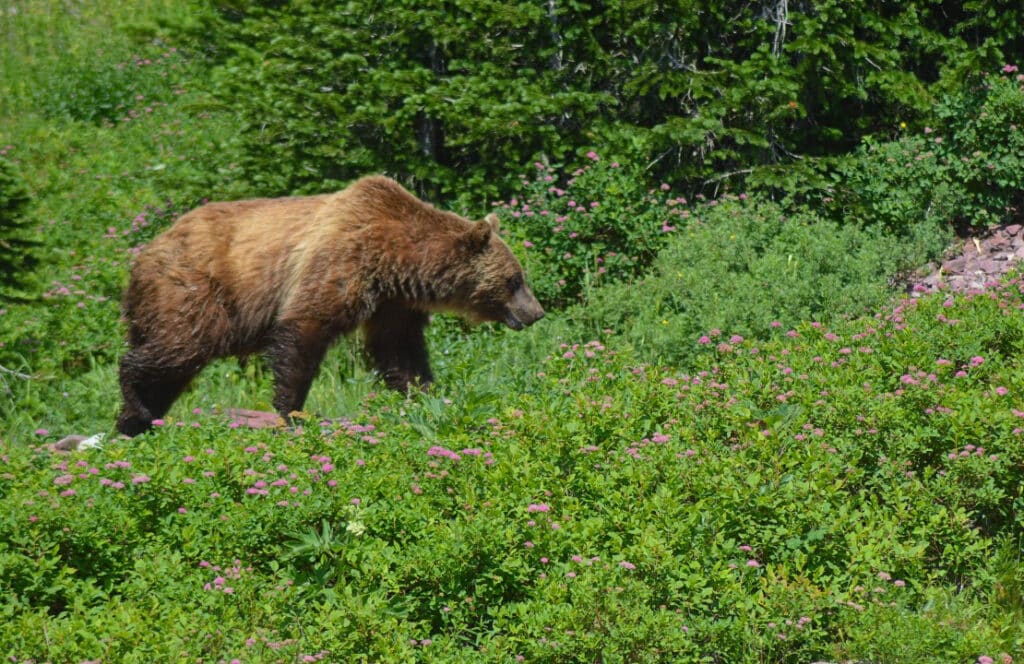
Another popular area for wildlife spotting is Hayden Valley, located nearly right in the center of Yellowstone National Park.
This area is similar to Lamar Valley in that it’s a large prairie where animals love to roam, and it’s easy to spot them.
The Yellowstone River winds through this valley, and bison enjoy lounging around the water.
You may also see elk, coyotes, and pronghorns as they, too, enjoy grazing the expansive fields of Hayden Valley.
Both grizzly and black bears may be seen roaming through the valley at certain times of day, especially at dawn and dusk, but you’ll have to look closely for them!
Keep an eye out for people stopped with large cameras or binoculars. There are many spots to stop along the road.
Fishing Bridge
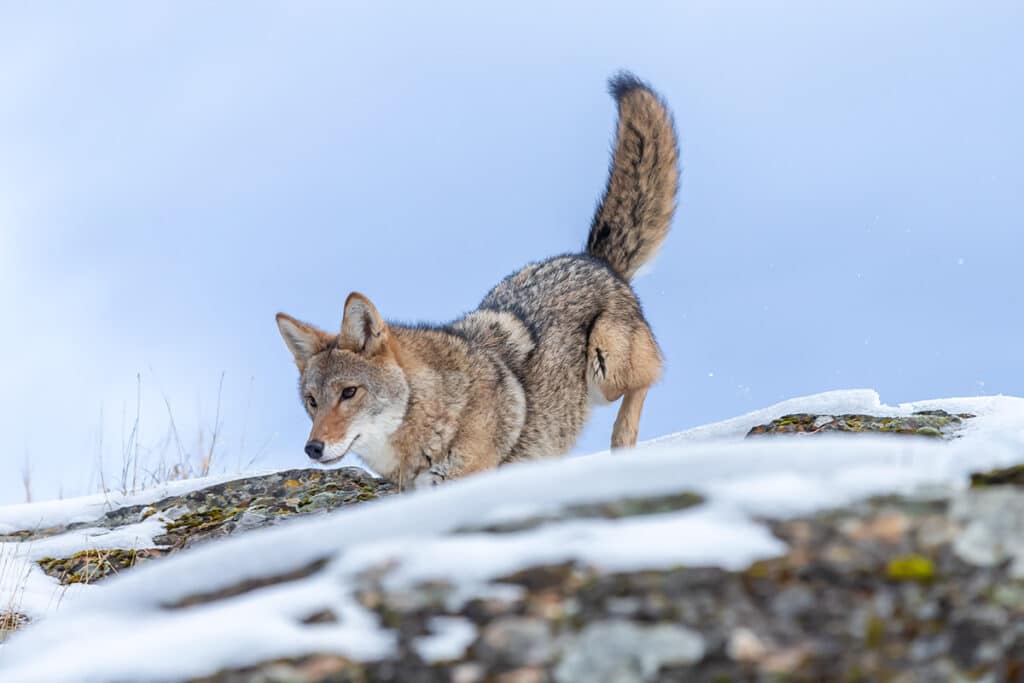
The fishing bridge isn’t too far from Hayden Valley, just a few miles south, closer to the large Yellowstone Lake.
This area is close to a visitor center and museum where you can learn more about the park.
The large log bridge was built in 1937 and was once a popular spot for fishing, but it’s not allowed anymore due to the declining trout population.
If you look into the lake, you may be able to see some of the large population of cutthroat trout.
Bears like hanging out around the fishing bridge because of the fish. An interesting fact is that because of the frequent bears, no tents are allowed at the Fishing Bridge Campground!
You also might see large birds like bald eagles and osprey.
There are picnic tables nearby, so this is a great spot to pack a lunch for the day and spend some time watching animals!
South Entrance
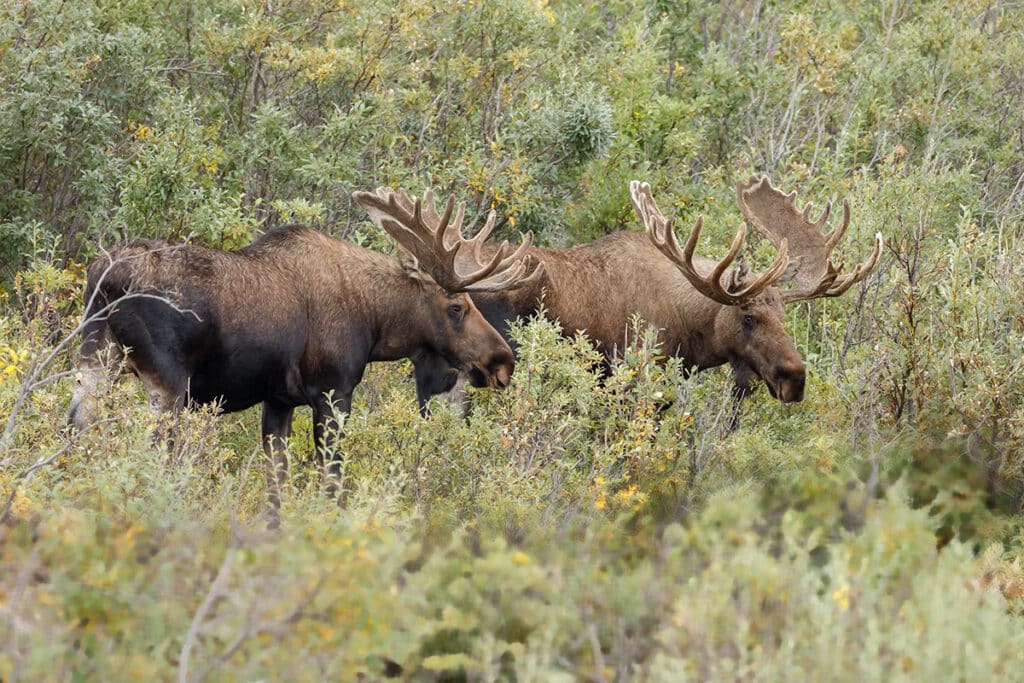
The southern entrance to Yellowstone National Park leads you right into Grand Teton National Park, which is another popular area in Wyoming that has even more wildlife for you to see.
Read More: Guide to the Best Hikes in Grand Teton National Park
Moose are the largest member of the deer family that lives in Yellowstone, and they’re most commonly found around the South Entrance.
Because of a loss of old-growth forests and hunting, the moose population has steadily declined, and there are now less than 200 in the park.
So if you want to see one, it’s best to look for them around the southernmost entrance, where they typically hang out either alone or in very small family groups.
Be sure to look closely though, as they tend to hide very well and blend in when standing up against trees and forests!
Mammoth Hot Springs
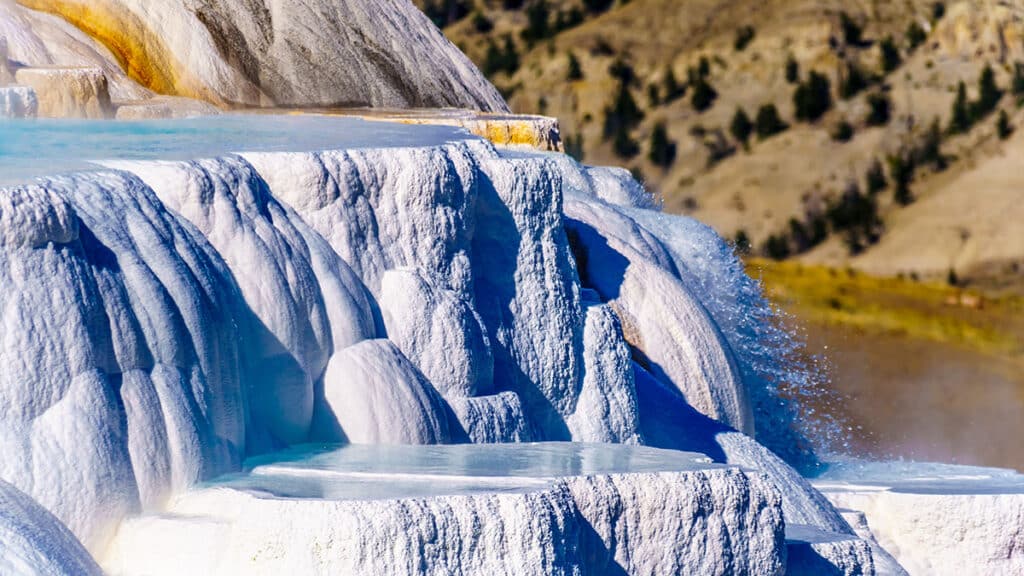
Mammoth Hot Springs is one of the most popular areas in the park, located nearest to the North Entrance, where you can find beautiful hot springs cascading down a hill.
Bison and elk tend to wander around the area of Mammoth Hot Springs, especially during the fall months.
During September and October, elk are in rut, or in their mating season, and tend to flock to the Mammoth area and hang out around here during the winter months too.
You also might see bison around the area, grazing on the grass near the buildings.
Tower-Roosevelt
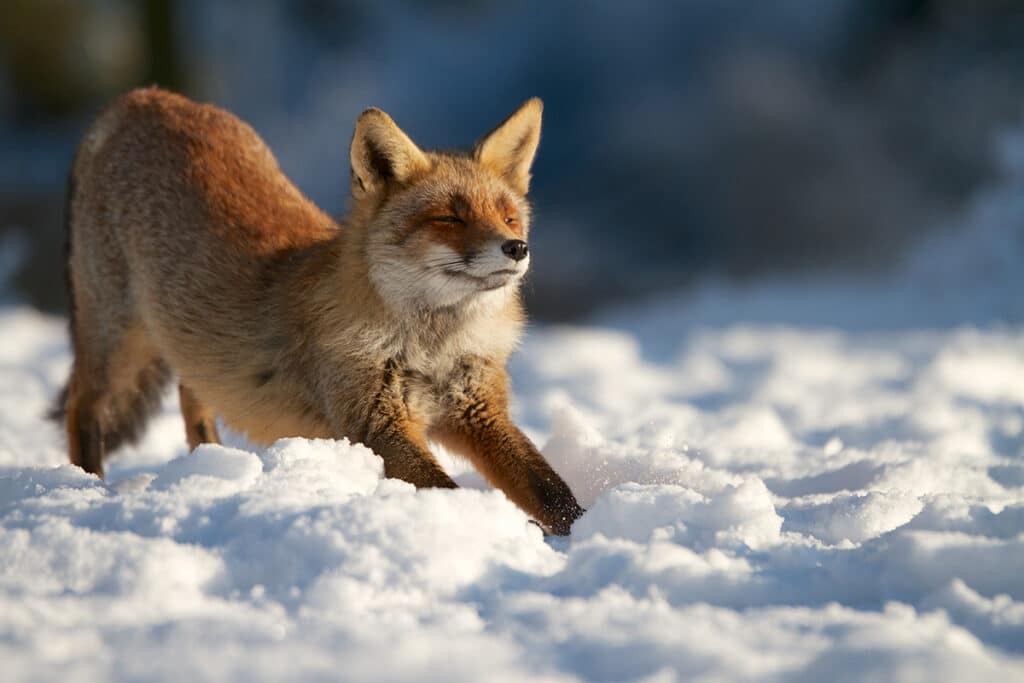
The Tower-Roosevelt area of Yellowstone National Park is located in the northeastern corner of the park and is found nearest to the Northeast Entrance.
Lamar Valley is actually just down the road from Tower-Roosevelt, so you may be able to pair the two together and make one great wildlife viewing day.
If you’re looking to spot bighorn sheep in Yellowstone, this is the area that you’ll want to be in, as there are steep, columnar basalt cliffs that they use as their habitat.
You might also see large birds, such as osprey or hawks, around this area, nesting in tall cliffs.
Gardiner Basin
During the cold, winter months, many animals come down into the lower elevations to stay warmer, rather than being up in high altitudes.
Many of them tend to head into the Gardiner Basin, near the town of Gardiner, around the northern entrance.
You might see bison or elk just roaming the streets of the small town!
This area is around Mammoth Hot Springs, so you can easily pair the two together.
What Kind of Wildlife is in Yellowstone National Park?
Some of the country’s best wildlife can be found in Yellowstone National Park, and people from all over the world come to view them in their natural habitat.
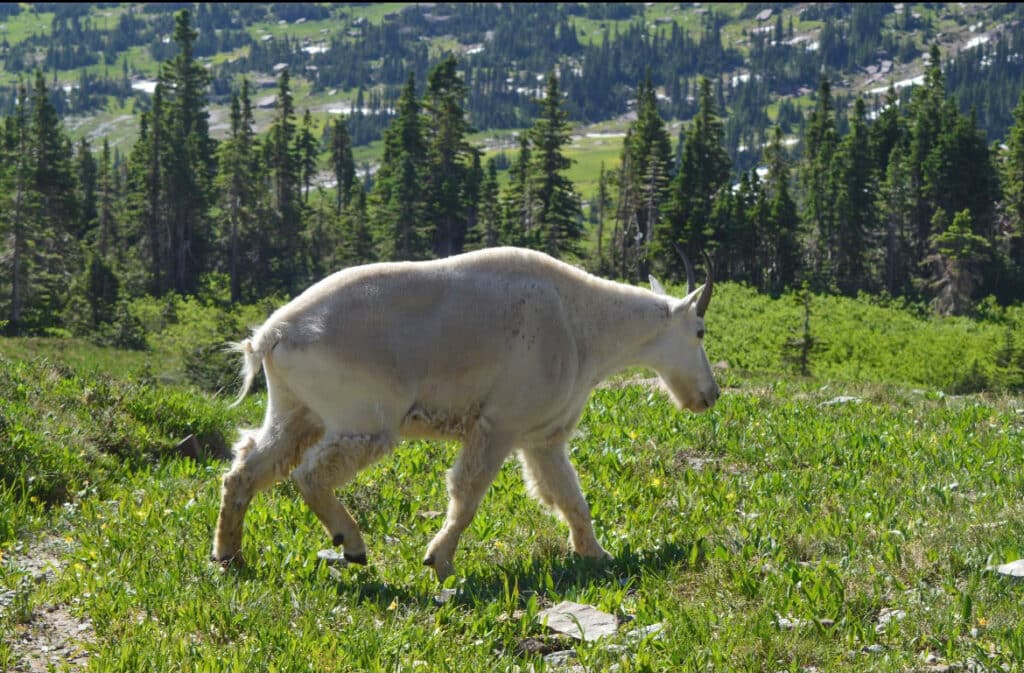
Below you’ll find a list of the most popular animals to spot in wildlife and the most popular places to see them.
- Bison: Lamar Valley, Hayden Valley, Mammoth Hot Springs, Gardiner Basin, and large grasslands
- Elk: Lamar Valley, Madison Canyon, and grasslands
- Bears: Lamar Valley, Hayden Valley, Dunraven Pass, Gardiners Hole, large meadows, alongside roadways
- Moose: Southern entrance, Soda Creek Butte, marshy areas
- Wolves: Lamar Valley, Hayden Valley, Grand Canyon of the Yellowstone area
- Bighorn Sheep: Mount Washburn, Tower-Roosevelt
- Mountain Goats: Steep cliffs, alpine habitats
You can also find other animals such as foxes, coyotes, birds, pronghorn, mule deer, mountain lions (very rarely seen), and more.
Which Part of Yellowstone Has the Most Wildlife?
Yellowstone National Park is one of the best places to see wildlife in the US, especially large mammals, in their natural habitat.
You can find them almost anywhere within the park, including roadways, hiking trails, back in the deep woods, in trees, lakes, campgrounds, and pretty much anywhere else you can think of.
After all, the entire park is their home, as they are wild animals, so they roam wherever they please!
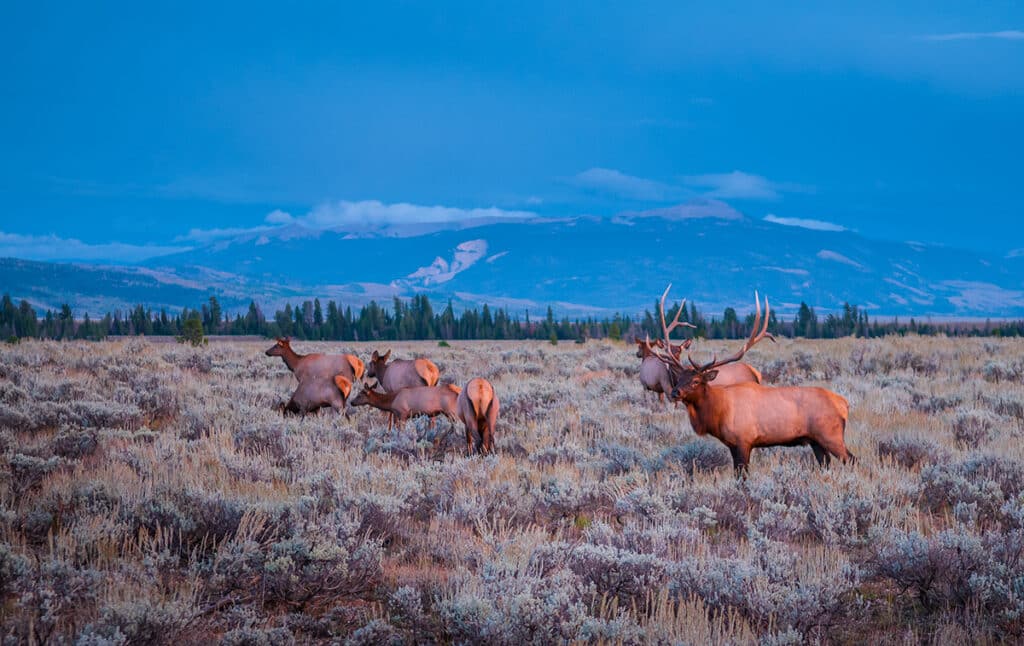
But if you’re wondering where the best places to see wildlife in Yellowstone are, head to Lamar and Hayden Valleys.
These huge grasslands are the perfect places to see grazing bison, roaming elk, and bears running after prey.
Best Time to See Wildlife in Yellowstone National Park
There is no set timer on when wildlife will be active within the park because, again, they are wild and do as they please.
But if you’re looking for the absolute best chances to see some of Yellowstone’s best animals, plan to visit during these times of the year and day.
Spring, between April and May, is typically the best time to visit Yellowstone if you’re on the hunt for wildlife.
These months are when bears are coming out of hibernation and are grazing in the fields and on the sides of the roads, filling up on food.
You also can find lots of other active animals in Yellowstone because the temperatures aren’t as hot as they tend to get in the summer months.
Winter is a great time to see wolves because they come out of their dens and can be spotted easier as they walk across a snowy field. It’s also a time when many other types of animals move into lower elevations, making them much easier to spot.
Summer can also be a great time to visit Yellowstone and see wildlife, but plan to get up early to see them before the day gets too hot and also to see many other visitors. Some animals also migrate into higher elevations during summer to get out of the heat, which can make it tough to see them.
No matter what time of year you visit, the best time to see wildlife is at dusk and dawn because this is when most animals come out to feed.
Especially during the summer, animals are most active during the cooler parts of the day, which are early morning and evening.
Safety for Wildlife Viewing
Although these animals are within a national park, it is still very important to remember that they are wild animals and can become aggressive.
People have been hurt and killed in the past by animals in the park, so it’s very important to take safety precautions.
Here are a few of the top tips for keeping yourself safe when you’re wanting to see wildlife in Yellowstone:
- Keep a distance of at least 100 yards away from bears and wolves and at least 25 yards from all other animals in Yellowstone.
- If an animal becomes aggressive or starts to approach you, slowly back away and keep a safe distance between you and it.
- Carry bear spray when hiking in bear country, which can easily be packed into your hiking backpack, and remember that there is strength in numbers, so it’s best not to hike alone.
- Never approach wildlife, even if they look cute and cuddly, because they can get aggressive very quickly.
- When you’re watching wildlife from the road, don’t stop in the middle of the road or park somewhere that isn’t a roadside pullout. This causes traffic jams.
- Be aware that all animals in Yellowstone can be dangerous and should be treated as such. Keeping your distance, being aware of their location, and carrying bear spray for your safety.
- If you’re out hiking, picnicking, or just enjoying the park, remember to never leave your backpack lying around, as the smell might attract bears.
Tips for Visiting Yellowstone National Park
Yellowstone National Park is a beautiful place with millions of visitors each year. During your visit, there are a few things that you should know to have an enjoyable time.
- Visit during the off seasons (spring, fall, and winter) to avoid waiting in long traffic lines, meeting lots of people on trails, and having to worry about finding a parking spot.
- Keep an eye out for large groups of people gathered along the side of the road, as this usually means there’s an animal.
- Book your accommodations in advance because of the busyness of the park.
- Plan extra time into your itinerary in the event that you get stuck in a bison jam, can’t find a parking spot or are waiting for a geyser to erupt longer than planned.
- Start as early as possible because not only is it the best time for spotting wildlife but also for snagging parking spots and beating others to the trail.
- Follow the Leave No Trace principles, including packing out any trash, leaving behind what you find, and leaving the animals alone.
- Have your America the Beautiful National Park pass to ensure that you can easily get into the park.
Conclusion
If you’re a wildlife and nature lover, then a visit to Yellowstone National Park is going to be a great vacation or trip for you to take.
Seeing large wildlife such as bears, elk, and bison in the wild is an incredible experience and is something that everyone should add to their bucket list!
Once you’ve planned a vacation to this park, it’s time to start planning where to see wildlife in Yellowstone National Park, and this post has you covered on the best places for just that!
About the Author
Kassidy is an Avid hiker, a weekend adventurer, a trail explorer, and the creative mind behind The Hiking Helper. Head to her blog for all things hiking.
More on Nature Adventures in the US
- When and Where to See Animals in the Wild: Guide to Wildlife Watching
- Complete Guide to Watching Polar Bears in Churchill, Manitoba
- Top National Parks in New Mexico to Fall in Love with in 2023
- 10 Best Destinations to See Wildlife in Alaska
- 6 Amazing National Parks in Florida You Have to Visit
- 24 Stunning Canyons in the US to Add to Your Bucket List
- 7 Best Places to See Wildlife in Yellowstone National Park
- 7 Top Nature Adventures in Santa Barbara, CA
- 26 Glacier Cruise in Alaska – Tour Review
- Things To Do in Nantucket: Nature and Wildlife

